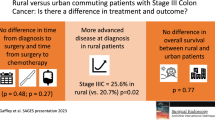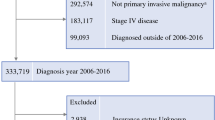Abstract
Objectives
Rural patients experience disparities in cancer care compared to urban patients. We hypothesized that rural patients with colon cancer who traveled to high-volume centers for treatment have similar survival compared to urban patients who also traveled to high-volume centers to seek treatment for colon cancer.
Methods
The National Cancer Database was interrogated for patients treated for stage I–III colon cancer (2004–2015). Travel distance to treatment centers and annual hospital volume were divided into quartiles. Two groups of patients were identified and compared: (1) rural patients who traveled to high-volume hospitals and (2) urban patients who also traveled to high-volume centers. The primary outcome was overall survival (OS).
Results
Of 647,949 patients, 634, 447 were urban and 13,502 were rural. Rural patients were more likely to be Caucasian, with lower income, more comorbidities, and be treated at non-academic centers. In multivariable analysis, rural patients had worse OS compared to urban patients (hazard ratio [HR] 1.08; 95% confidence interval [CI] 1.04–1.12; p = < 0.001). There were 46,781 (7%) urban patients and 1276 (9%) rural patients who traveled a long distance (median 40 and 108 miles, respectively) to high-volume centers. There was no difference in adjusted OS between urban and rural patients who traveled to high-volume centers for treatment (HR 1.06; 95%CI 0.94–1.20; p = 0.36).
Conclusions
This nationwide analysis suggests that rural patients with colon cancer experience worse survival than urban patients, but that this disparity might be mitigated by rural patients traveling to high-volume centers for treatment.


Similar content being viewed by others
References
Key Statistics for Colorectal Cancer [Internet]. [cited 2018 Jan 14];Available from: https://www.cancer.org/cancer/colon-rectal-cancer/about/key-statistics.html
Singh GK, Williams SD, Siahpush M, Mulhollen A. Socioeconomic, Rural-Urban, and Racial Inequalities in US Cancer Mortality: Part I—All Cancers and Lung Cancer and Part II—Colorectal, Prostate, Breast, and Cervical Cancers [Internet]. J. Cancer Epidemiol. 2011 [cited 2018 Jan 2];Available from: https://www.hindawi.com/journals/jce/2011/107497/?links=false
Cromartie J. Rural America at a Glance, 2017 Edition [Internet]. [cited 2018 Jan 14];Available from: https://www.ers.usda.gov/publications/pub-details/?pubid=85739
Birkmeyer JD, Sun Y, Wong SL, Stukel TA. Hospital Volume and Late Survival After Cancer Surgery. Ann Surg 2007;245(5):777–783.
Dimick JB, Cowan JA, Upchurch GR, Colletti LM. Hospital volume and surgical outcomes for elderly patients with colorectal cancer in the United States1 1Presented at the Annual Meeting of the Association for Academic Surgery, Boston, MA, November 7th–9th, 2002. J Surg Res 2003;114(1):50–56.
Weitz J, Koch M, Friess H, Büchler MW. Impact of Volume and Specialization for Cancer Surgery. Dig Surg 2004;21(4):253–261.
Campbell NC, Elliott AM, Sharp L, Ritchie LD, Cassidy J, Little J. Rural and urban differences in stage at diagnosis of colorectal and lung cancers. Br J Cancer 2001;84(7):910–914.
Liff JM, Chow WH, Greenberg RS. Rural-urban differences in stage at diagnosis. Possible relationship to cancer screening. Cancer 1991;67(5):1454–1459.
Higginbotham JC, Moulder J, Currier M. Rural v. urban aspects of cancer: first-year data from the Mississippi Central Cancer Registry. Fam Community Health 2001;24(2):1–9.
Baade PD, Turrell G, Aitken JF. Geographic remoteness, area-level socio-economic disadvantage and advanced breast cancer: a cross-sectional, multilevel study. J Epidemiol Community Health 2011;jech.2010.114777.
Mandelblatt J, Andrews H, Kao R, Wallace R, Kerner J. The late-stage diagnosis of colorectal cancer: demographic and socioeconomic factors. Am J Public Health 1996;86(12):1794–1797.
Pleis JR, Ward BW, Lucas JW. Summary health statistics for U.S. adults: National Health Interview Survey, 2009. Vital Health Stat 10 2010;(249):1–207.
National Center for Health Statistics (US). Health, United States, 2010: With Special Feature on Death and Dying [Internet]. Hyattsville (MD): National Center for Health Statistics (US); 2011 [cited 2018 Jan 13]. Available from: http://www.ncbi.nlm.nih.gov/books/NBK54381/
Parikh-Patel A, Bates JH, Campleman S. Colorectal cancer stage at diagnosis by socioeconomic and urban/rural status in California, 1988–2000. Cancer 2006;107(S5):1189–1195.
Lutfiyya May Nawal, Lipsky Martin S., Wisdom-Behounek Jennifer, Inpanbutr-Martinkus Melissa. Is Rural Residency a Risk Factor for Overweight and Obesity for U.S. Children? Obesity 2012;15(9):2348–2356.
Jackson J. Elizabeth, Doescher Mark P., Jerant Anthony F., Hart L. Gary. A National Study of Obesity Prevalence and Trends by Type of Rural County. J Rural Health 2006;21(2):140–148.
Zahnd WE, Scaife SL, Francis ML. Health Literacy Skills in Rural and Urban Populations [Internet]. 2009 [cited 2018 Apr 30];Available from: http://www.ingentaconnect.com/content/png/ajhb/2009/00000033/00000005/art00008
Cole AM, Jackson JE, Doescher M. Urban–rural disparities in colorectal cancer screening: cross-sectional analysis of 1998–2005 data from the Centers for Disease Control’s Behavioral Risk Factor Surveillance Study. Cancer Med 2012;1(3):350–356.
Wong SL. Lymph Node Counts and Survival Rates After Resection for Colon and Rectal Cancer. Gastrointest Cancer Res GCR 2009;3(2 Suppl 1):S33–S35.
Nelson H, Petrelli N, Carlin A, et al. Guidelines 2000 for colon and rectal cancer surgery. J Natl Cancer Inst 2001;93(8):583–596.
Chang GJ, Rodriguez-Bigas MA, Skibber JM, Moyer VA. Lymph node evaluation and survival after curative resection of colon cancer: systematic review. J Natl Cancer Inst 2007;99(6):433–441.
McGory ML, Shekelle PG, Ko CY. Development of quality indicators for patients undergoing colorectal cancer surgery. J Natl Cancer Inst 2006;98(22):1623–1633.
Schrag D, Cramer LD, Bach PB, Cohen AM, Warren JL, Begg CB. Influence of Hospital Procedure Volume on Outcomes Following Surgery for Colon Cancer. JAMA 2000;284(23):3028–3035.
Fong Y, Gonen M, Rubin D, Radzyner M, Brennan MF. Long-Term Survival Is Superior After Resection for Cancer in High-Volume Centers. Ann Surg 2005;242(4):540–547.
Nathan H, Cameron JL, Choti MA, Schulick RD, Pawlik TM. The Volume-Outcomes Effect in Hepato-Pancreato-Biliary Surgery: Hospital Versus Surgeon Contributions and Specificity of the Relationship. J Am Coll Surg 2009;208(4):528–538.
Porter GA, Soskolne CL, Yakimets WW, Newman SC. Surgeon-related factors and outcome in rectal cancer. Ann Surg 1998;227(2):157–167.
Liu JH, Zingmond DS, McGory ML, et al. Disparities in the Utilization of High-Volume Hospitals for Complex Surgery. JAMA 2006;296(16):1973–1980.
Birkmeyer JD, Siewers AE, Marth NJ, Goodman DC. Regionalization of High-Risk Surgery and Implications for Patient Travel Times. JAMA 2003;290(20):2703–2708.
Finlayson SR, Birkmeyer JD, Tosteson AN, Nease RF. Patient preferences for location of care: implications for regionalization. Med Care 1999;37(2):204–209.
Monroe AC, Ricketts TC, Savitz LA. Cancer in rural versus urban populations: a review. J Rural Health Off J Am Rural Health Assoc Natl Rural Health Care Assoc 1992;8(3):212–220.
Author information
Authors and Affiliations
Contributions
Study design (MAA, MCT, JM); data acquisition (VR, MAA, MCT); interpretation (all authors); drafting manuscript (all authors); final approval (all authors); responsibility for the accuracy and integrity of the work (all authors).
Corresponding author
Additional information
Publisher’s Note
Springer Nature remains neutral with regard to jurisdictional claims in published maps and institutional affiliations.
Rights and permissions
About this article
Cite this article
Raman, V., Adam, M.A., Turner, M.C. et al. Disparity of Colon Cancer Outcomes in Rural America: Making the Case to Travel the Extra Mile. J Gastrointest Surg 23, 2285–2293 (2019). https://doi.org/10.1007/s11605-019-04270-5
Received:
Accepted:
Published:
Issue Date:
DOI: https://doi.org/10.1007/s11605-019-04270-5




